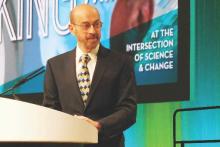CHICAGO – Statin-associated muscle symptoms are real for roughly 40% of patients with a history of this adverse effect, and for such patients who are truly unable to tolerate a statin treatment, a PCSK9 inhibitor provided an effective and well-tolerated alternative in a randomized trial with more than 500 patients.
“Controversy has surrounded the issue of statin-associated muscle symptoms because of large differences in the incidence of this disorder in randomized trials and observational studies. The GAUSS-3 study results demonstrate that muscle-related intolerance is reproducible during blinded statin rechallenge in a substantial fraction, about 40%, of patients with a history of symptoms,” Dr. Steven E. Nissen said at the annual meeting of the American College of Cardiology. “Alternative approaches to reducing low-density lipoprotein cholesterol in these patients represents an important medical priority.”
Statin intolerance has been a challenging diagnosis for physicians to confirm because no biomarker exists to definitively document it, which led to this study to test a more systematic and objective approach to confirm the diagnosis, explained Dr. Nissen, chairman of the department of cardiology at the Cleveland Clinic. GAUSS-3 (Goal Achievement After Utilizing an Anti-PCSK9 Antibody in Statin Intolerant Subjects 3), run at 53 centers worldwide, included two distinct phases.
In the first phase, researchers enrolled 511 patients with elevated LDL cholesterol levels who had a history of an inability to tolerate treatment with atorvastatin plus at least one other statin or at least three statins of any type. Following a 4-week washout period with no lipid-lowering treatments, they randomized patients to 10 weeks of 20 mg atorvastatin daily or placebo, followed by crossover to the alternative treatment for an additional 10 weeks. The patients averaged 61 years old, with an average LDL cholesterol level of 212 mg/dL.
During this phase, 43% of the patients reported having intolerable muscle symptoms while on atorvastatin, but not on placebo. In addition, 27% reported intolerable muscle symptoms while on placebo but not on atorvastatin, demonstrating the high incidence of psychosomatic muscle symptoms experienced by many patients with this history, Dr. Nissen noted. This placebo-controlled statin rechallenge provides a model for how clinicians can reliably confirm which patients experience statin-specific muscle symptoms.
“This gives physicians a strategy for managing these patients. This was the best strategy we could use to find out who really has intolerance,” Dr. Nissen said.
The second phase included 218 patients who had their muscle symptoms confirmed in the first phase plus a small number of patients with a history of muscle-related statin intolerance who skipped the first phase because their serum creatinine kinase level was greater than 10-times above the upper limit of normal. The researchers randomized these patients to treatment with either a monthly subcutaneous injection with 420 mg of evolocumab (Repatha) or 10 mg of oral ezetimibe (Zetia) given daily. To maintain blinding, all patients received simultaneous placebo treatment that mimicked the drug they were not assigned to receive. The patients enrolled in the second phase had an average entry LDL cholesterol level of about 220 mg/dL.
After 24 weeks on treatment, patients on ezetimibe had an average 17% reduction in their LDL cholesterol level, while those on evolocumab had an average reduction of 53%. An LDL cholesterol level of less than 100 mg/dL was achieved in 2% of the ezetimibe patients and in 64% of those on evolocumab. Muscle-related symptoms occurred in 29% of the ezetimibe patients and in 21% of those on evolocumab, but discontinuations because of muscle symptoms were limited to 1 patient on evolocumab and 5 patients on ezetimibe, Dr. Nissen reported. Concurrent with his report at the meeting, an article with the results appeared online (JAMA. 2016 Apr 3. doi: 10.1001/jama.2016.3608).
“These findings show that it pays to be patient” when dealing with patients who report statin-associated muscle symptoms as more than half of them were able to tolerate the daily 20 mg atorvastatin challenge for 10 weeks, commented Dr. Frederick A. Masoudi, a cardiologist and professor of medicine at the University of Colorado at Denver, Aurora. The report also “gives us a better approach for dealing with patients who have this nonspecific reaction to statin treatment, which remains the mainstay of cholesterol-lowering treatment.”
Dr. Nissen stressed that in his opinion, it is appropriate to use a PCSK9 inhibitor in this off-label way despite the controversial high cost for these drugs. “We have to do something for these patients who say that they cannot take a statin, but have multiple coronary disease risk factors and LDL cholesterol levels above 200 mg/dL. They are an accident waiting to happen. I am unwilling to leave patients with an LDL cholesterol of 200 mg/dL who can’t take statins and just walk away.”




